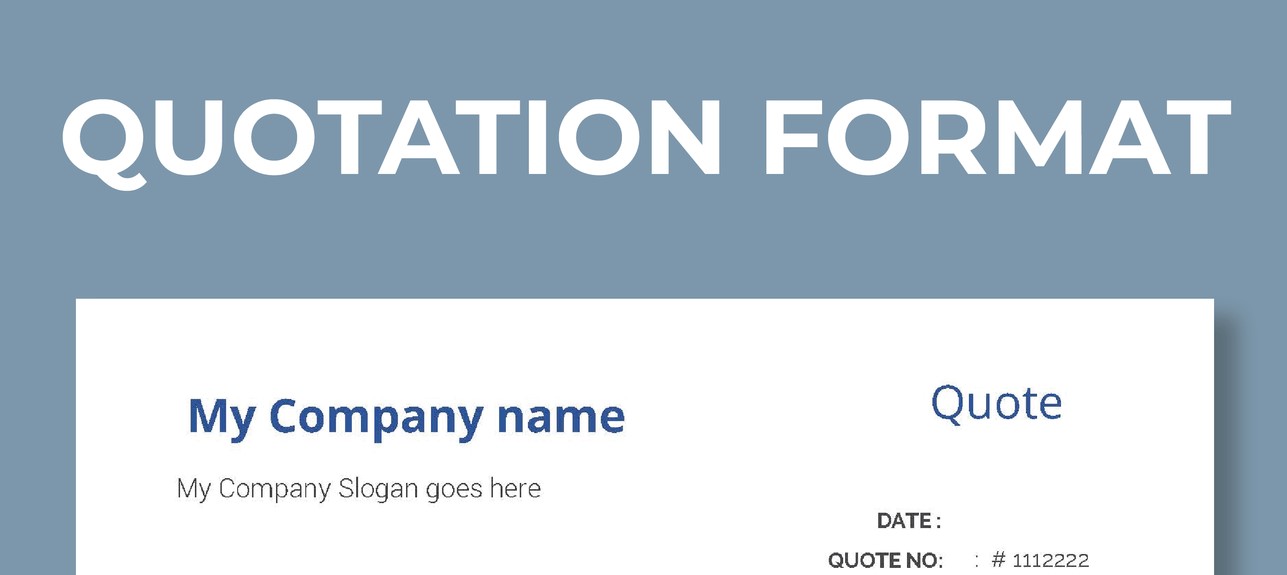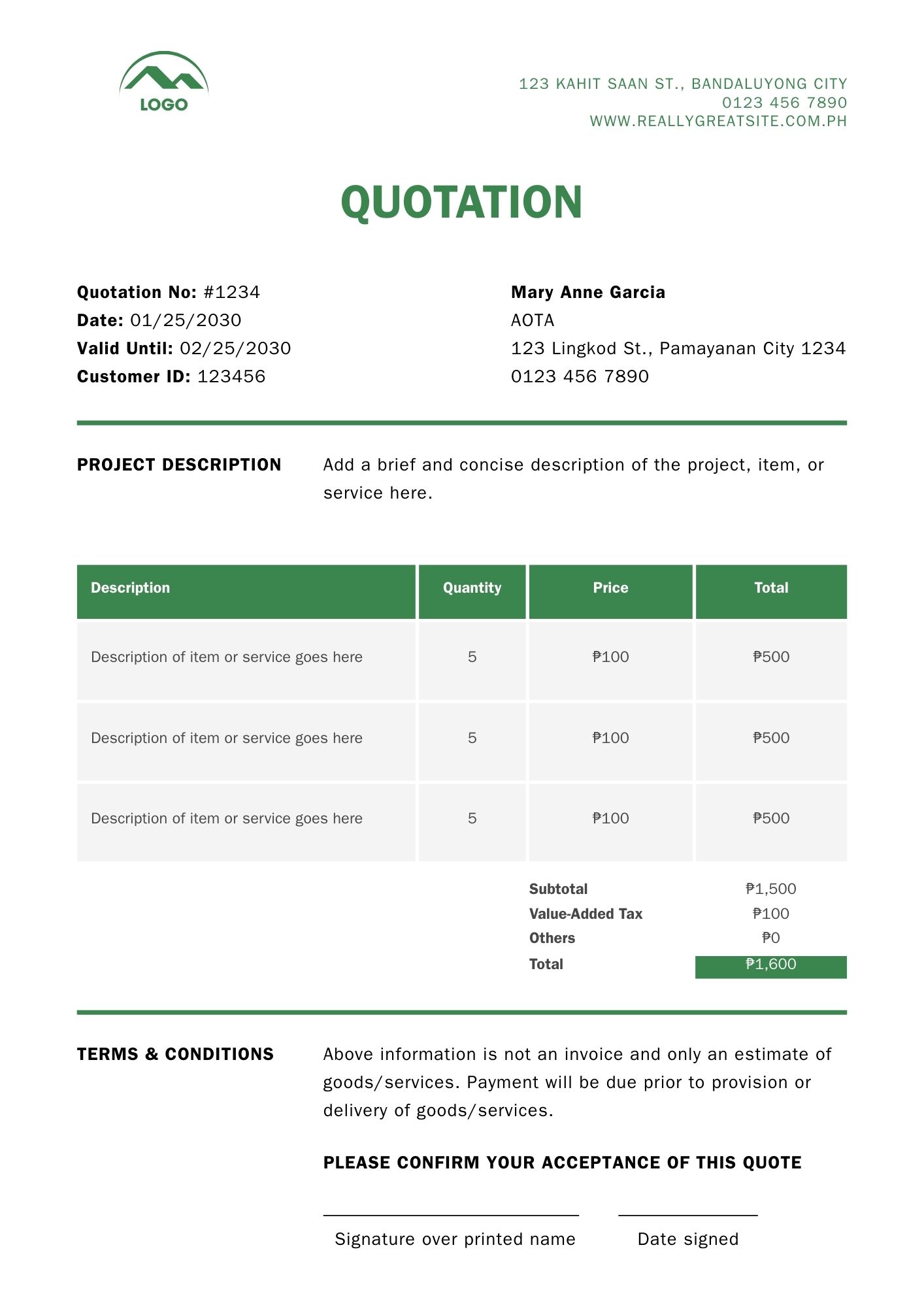
In the fast-paced world of business, first impressions matter. One of the most important documents that can make or break a professional relationship is a quotation. A well-structured quotation format communicates clarity, professionalism, and reliability. It helps your clients understand exactly what you are offering, at what price, and under what terms. In this blog, we will walk you through everything you need to know about creating a good quotation format—from understanding what it is, its essential components, step-by-step creation, common mistakes, and tips to make it stand out.
A quotation is not just a list of prices; it is a representation of your business. A professionally crafted quotation conveys trustworthiness and ensures transparency in dealings with clients. Whether you are offering products or services, a proper quotation acts as a formal agreement between your business and the client. A poorly prepared quotation, on the other hand, can confuse the client, delay decisions, or even lose potential business.
Quotations are crucial for:
- Communicating pricing clearly
- Setting expectations for delivery and service
- Acting as a reference for contractual agreements
Understanding how to make a good quotation format ensures that your business always projects professionalism and reliability.
Understanding What a Quotation Is
A quotation, also referred to as a quote, is a formal document that provides a detailed estimate of the cost of products or services. It is typically prepared in response to a client’s request or inquiry. Unlike a casual estimate, a quotation is legally binding once accepted by the client. This makes it crucial to be precise and clear in all details.
Key purposes of a quotation include:
- Providing a clear price estimation: Helps clients understand the total cost before committing.
- Ensuring transparency: Details of the product, service, or project avoid confusion.
- Acting as a legal reference: Protects both the client and your business in case of disputes.
Situations requiring a quotation:
- New project proposals
- Service requests from clients
- Sale of bulk products
- Customized solutions or products
Key Elements of a Good Quotation Format
A professional quotation should include all relevant information in an organized manner. Here are the key elements:

1. Company Information
Your company details must appear at the top. This typically includes:
- Company name
- Logo
- Address
- Contact details (phone, email, website)
Including your branding ensures clients can immediately recognize your company and adds credibility.
2. Client Information
Clearly mention the client’s name and company. Include:
- Client’s contact person
- Company name
- Address
- Contact information
This ensures the quotation is personalized and avoids confusion if multiple clients are involved.
3. Quotation Number & Date
Every quotation should have a unique number and date.
- Quotation Number: Helps in tracking and record-keeping.
- Date: Indicates when the quotation was issued and is useful for validity purposes.
4. Product/Service Details
This is the core of your quotation. Include:
- Description of products/services
- Quantity or hours of service
- Unit price
- Total price for each item
Use tables to make the details organized and easy to read.
5. Terms and Conditions
Clearly outline the terms of the quotation:
- Payment terms (advance, credit period, methods)
- Delivery or service timeline
- Warranty or support information
- Validity period of the quotation
6. Taxes & Additional Charges
Mention applicable taxes such as GST or VAT. Include any additional charges like shipping, handling, or installation fees.
7. Total Amount
Highlight the final amount clearly, often in bold or separate row in the table. This ensures the client sees the total at a glance.
8. Signature Section
Include a section for the authorized signatory with name, designation, and date. This adds authenticity and professionalism.
Step-by-Step Guide to Create a Quotation Format
Creating a professional quotation does not have to be complicated. Here’s a step-by-step approach:
Step 1: Choose the Right Software
You can create quotations using:
- Word processors like Microsoft Word or Google Docs
- Spreadsheet software like Excel or Google Sheets (great for calculations)
- Online quotation tools or templates
Choose the software that aligns with your workflow and allows for easy editing and sharing.
Step 2: Structure the Quotation
Follow a structured layout:
- Header: Company logo and contact details
- Client information and quotation number
- Table with products/services, quantity, unit price, and total
- Additional costs, taxes, and total amount
- Terms and conditions
- Signature section
A clean structure improves readability and makes your quotation look professional.
Step 3: Format for Clarity
- Use tables for product/service details
- Keep fonts simple and readable (Arial, Calibri, or Times New Roman)
- Highlight total amount with bold text
- Maintain consistent spacing for a clean look
Step 4: Include Optional Elements
Depending on your business and client needs, you can add:
- Discounts or promotional offers
- Notes or special instructions
- Payment links for digital quotations
Step 5: Review Before Sending
Check for:
- Accuracy in pricing and calculations
- Correct client details
- Consistency in terms and conditions
- Spelling and grammar errors
Common Mistakes to Avoid
Even small errors can make your quotation look unprofessional. Avoid these mistakes:
- Missing key details: Leaving out client info or terms can confuse the client.
- Confusing terms and conditions: Keep it simple and clear.
- Overly complicated design: Avoid cluttered tables or unnecessary graphics.
- Not mentioning quotation validity: Always specify how long the offer is valid.
Tips to Make Your Quotation Stand Out
To create an impactful quotation, consider the following tips:
- Professional design and branding: Use your logo, brand colors, and fonts.
- Clear and simple language: Avoid jargon or unnecessary technical terms.
- Highlight key information: Bold totals and important deadlines.
- Personal touch: Add a brief greeting or thank-you note for better client engagement.
Sample Quotation Format
Here’s an example of a professional quotation format:
| Item | Description | Quantity | Unit Price | Total Price |
|---|---|---|---|---|
| 1 | Website Development | 1 Project | Rs50,000 | Rs50,000 |
| 2 | SEO Services | 6 Months | Rs10,000/Month | Rs60,000 |
| 3 | Maintenance | 1 Year | Rs5,000 | Rs5,000 |
Subtotal: Rs115,000
GST (18%): ?20,700
Total Amount: ?135,700
Terms & Conditions:
- Payment: 50% advance, 50% upon project completion
- Delivery: 30 days from confirmation
- Validity: 30 days from quotation date
Authorized Signatory:
Name: ________
Designation: ________
Date: ________
Tools and Templates for Creating Quotation Formats
You don’t always need to start from scratch. Here are some tools and templates:
- Vyapaarkhata - All-in-one solution for invoice management and Quotation Creations
- Microsoft Word/Excel: Pre-built templates available for business quotations.
- Google Docs/Sheets: Free templates with collaborative features.
- Online quotation generators: Websites like InvoiceSimple, Zoho, and Canva provide easy customization.
- Customizable templates: For specific industries like construction, IT services, or retail.
Using templates saves time and ensures consistency across multiple quotations.
Creating a good quotation format is essential for any business. It not only communicates professionalism but also builds trust and ensures transparency with clients. By following the steps outlined in this guide, avoiding common mistakes, and using templates and tools wisely, you can create clear, precise, and professional quotations that improve your chances of winning business.
Remember, a well-crafted quotation is often the first impression a client gets of your company—make it count.
1. What is the difference between a quotation and an invoice?
A quotation is an estimate of costs sent before the client confirms the order, while an invoice is a bill sent after the service/product is delivered.
2. Can I create a quotation without a template?
Yes, but templates make the process faster and ensure a professional look.
3. How do I calculate taxes in a quotation?
Calculate the tax percentage on the subtotal and add it to the total price. Mention it separately for transparency.
4. How long is a quotation valid?
Typically, 15–30 days, but it depends on your business policy.
5. Should I include discounts in the quotation?
Yes, if applicable. It motivates clients to make a decision faster.
6. What is the standard format for business quotations?
A header with company info, client details, quotation number, table with product/service details, terms, taxes, total, and signature.
7. Can quotations be sent via email?
Absolutely. Digital quotations are standard practice today and can include PDFs or editable formats.
8. How do I ensure my quotation looks professional?
Use tables, clear fonts, branding elements, and review for errors before sending.
9. Are digital signatures acceptable in a quotation?
Yes, digital signatures are widely accepted, especially for online submissions.
10. How to handle multiple products/services in one quotation?
List all items in a table with individual pricing and total. Include notes if needed for clarity.
